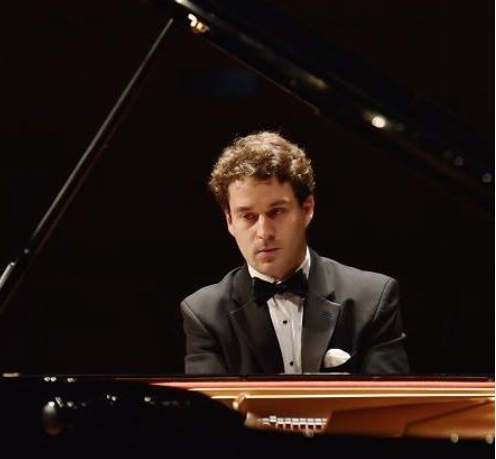Alexei Tartakovsky in Review
Alexei Tartakovsky, piano
Baisley Powell Elebash Recital Hall, The Graduate Center, CUNY, New York, NY
February 24, 2020
Pianist Alexei Tartakovsky appeared at Baisley Powell Elebash Recital Hall at the CUNY Graduate Center as part of the Ph.D/D.M.A. Programs in Music on February 24, 2020. He is currently pursuing his doctorate with Richard Goode at CUNY Graduate Center, where he was awarded the Graduate Center Fellowship.
Mr. Tartakovsky has an impressive list of accomplishments that the reader can learn more about by visiting https://www.atartakovsky.com/. His program was all twenty-four of Chopin’s Op. 28 Preludes, Einojuhani Rautavaara’s Passionale, and Schubert’s Sonata in B-flat major, D. 960.
The first half consisted of the Chopin. These Preludes have loomed large in this reviewer’s personal and professional life, and consequently, some rather strong opinions have developed about how these pieces should be played. (The reader might already be thinking that my objectivity is compromised, but rest assured I do not claim to own the truth, only my truth.)
Mr. Tartakovsky’s excellent program notes about the Preludes quote Schumann (some rather backhanded compliments), and Liszt (more generous praise). I would like to add two more. Musicologist Henry Finck said that, “if all piano music in the world were to be destroyed, excepting one collection, my vote should be cast for Chopin’s Preludes.” Chopin biographer Jeremy Nicholas writes that, “Even on their own, the 24 Preludes would have ensured Chopin’s claim to immortality.”
With all that being said, let’s get to it. Mr. Tartakovsky’s conception of the preludes is to treat the set as a single work with (as he states in his notes) “a clear beginning, middle, and end.” I am in general agreement with this concept, even if there is dispute over whether this was Chopin’s actual intent. It is a thoughtful, intelligent approach, and given Mr. Tartakovsky’s consistency in overall style, it also was compelling. That style was one of avoidance of any overt emotion or any exaggerated romanticism, basically “playing it straight.” For this listener, it struck me as overly cautious. It is certainly not a question a technique, as Mr. Tartakovsky has more than enough firepower to handle these works, and his accuracy was outstanding. I’m not wanting hyper-exaggerated emoting, but a little more exploration of emotional depth in a few preludes (notably the E minor, the F# major, and the A-flat major). To be fair, the G major and C# minor were exquisitely done, the D-flat major “Raindrop” had a surprising freshness of quality for such a well-known work, and the B-flat minor (which has caused innumerable pianists to crash and burn as they flew off the rails catastrophically) was lightning fast with each note clearly articulated – truly exceptional. Honorable mentions go to the E-flat major (another ferociously difficult prelude that has snuffed out the dreams of many a pianist), and the final Prelude in D minor. After the last of the three hammer blows on the low D, the audience gave Mr. Tartakovsky a standing ovation.
After intermission, Mr. Tartakovsky opened with Passionale, written in 2003 by Finnish composer Einojuhani Rautavaara. This listener is an admirer of Rautavaara’s works, so it was a wonderful bonus to hear this piece. Rautavaara is “modern” (for lack of a better term) in his harmonic language, but always remains highly accessible to the listener. Passionale is the modern Chopin or Liszt in its romantic conception, but the sound is unmistakably Rautavaara. Mr. Tartakovsky really let loose and “went for it” in a fantastic performance. It was easily the favorite of the night for this listener.
After the Passionale, Mr. Tartakovsky returned to the thoughtful, intellectual side with Schubert’s Sonata in B-flat major, D. 960. Written in the last year of Schubert’s life (1828), it was not published until ten years after the composer’s death. Mr. Tartakovsky writes in his notes that “one can’t help but feel that this sonata is Schubert’s epitaph to himself,” which is not altogether without reason. Thematic material and ideas from previous works abound throughout. Mr. Tartakovsky’s artistry was on full display here. The long lines and autumnal qualities that are much more difficult to render effectively than many realize were done with a natural, organic quality. It’s another thing to keep the listener involved in this very long sonata, but the audience was held in rapt attention, which is no mean feat. I have observed much restlessness from listeners in other performances (by “big name” artists), and that was not the case here. Mr. Tartakovsky can be proud of his superb playing. The audience rewarded him with a loud and extended standing ovation.
Mr. Tartakovsky offered two encores, Schubert’s Liebesbotschaft arranged by Liszt and Chopin’s Waltz in A-flat major, Op. 34. No.1, both played with graceful elegance.

